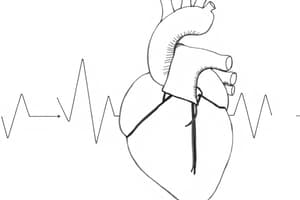Podcast
Questions and Answers
Decreased filling results in increased contractility.
Decreased filling results in increased contractility.
False (B)
Afterload refers to the resistance against which the heart contracts.
Afterload refers to the resistance against which the heart contracts.
True (A)
Catecholamines like dopamine and norepinephrine have negative inotropic effects on myocardial contractility.
Catecholamines like dopamine and norepinephrine have negative inotropic effects on myocardial contractility.
False (B)
Heart failure can result from impaired myocardial contractility.
Heart failure can result from impaired myocardial contractility.
Arrhythmias have no impact on cardiac muscle function.
Arrhythmias have no impact on cardiac muscle function.
Understanding myocardial contractility is not important for diagnosing or treating heart conditions.
Understanding myocardial contractility is not important for diagnosing or treating heart conditions.
Myocardial contractility refers to the ability of heart muscle cells to generate force during the relaxation phase of the cardiac cycle.
Myocardial contractility refers to the ability of heart muscle cells to generate force during the relaxation phase of the cardiac cycle.
Cardiac muscles are unique due to their smooth appearance.
Cardiac muscles are unique due to their smooth appearance.
The interaction between actin and myosin is essential for generating force during cardiac muscle contraction.
The interaction between actin and myosin is essential for generating force during cardiac muscle contraction.
Preload refers to the degree of stretch of the ventricle just before diastolic activity begins.
Preload refers to the degree of stretch of the ventricle just before diastolic activity begins.
Increased ventricular filling leads to weaker contractions.
Increased ventricular filling leads to weaker contractions.
Understanding myocardial contractility provides insight into potential issues such as hypertension.
Understanding myocardial contractility provides insight into potential issues such as hypertension.
Flashcards are hidden until you start studying
Study Notes
Myocardial Contractility: Understanding Cardiac Muscle Function
Myocardial contractility refers to the ability of the heart muscle cells (myocytes) to shorten and generate force during the contraction phase of the cardiac cycle. This process is essential for pumping blood throughout the body and maintaining adequate circulation. Understanding myocardial contractility provides insight into heart function and potential issues such as cardiomyopathies.
Cardiac Muscle Structure
Cardiac muscles are unique due to their striated appearance, which is a result of myofibrils with repeating bands called sarcomeres. These striations are formed by actin (thin filaments) and myosin (thick filaments), creating overlapping zones where energy-driven conformational changes occur.
Actin and Myosin Interaction
Actin and myosin play crucial roles in generating force during contraction. In relaxed state, two actin strands interact with one myosin head. When stimulated by a calcium ion, the myosin heads move along the actin strand while detaching from it, causing shortening of the sarcomere.
Regulation of Contractile Force
The strength of the heart's contractions can be modulated through various mechanisms including preload, afterload, and neurohumoral factors.
Preload and Afterload
Preload refers to the degree of stretch of the ventricle just before systolic activity begins. Increased ventricular filling leads to stronger contractions. Conversely, decreased filling results in reduced contractility. Afterload, in contrast, describes the resistance against which the heart contracts. Greater afterloads lead to increased pressures during diastole, forcing more blood into the systemic circulation.
Neurohumoral Factors
Several hormones influence contractility. For instance, catecholamines like dopamine and norepinephrine cause positive inotropic effects, enhancing myocardial contractility even under low perfusion conditions.
Disease States Affecting Myocardial Contractility
Various diseases impact myocardial contractility, such as heart failure and certain types of arrhythmias.
Heart Failure
Heart failure occurs when the heart cannot pump sufficient oxygen-rich blood to meet the body's demands. This condition may result from impaired myocardial contractility due to various causes, including inflammation, ischemia, infections, or genetic factors.
Arrhythmias
Arrhythmias, or irregular heartbeats, can also affect contractility. For example, atrial fibrillation, which is characterized by chaotic and extremely rapid atrial contractions, may lead to reduced ventricular filling and contractility.
In conclusion, myocardial contractility is a critical aspect of cardiac muscle function, enabling the heart to pump blood effectively. Understanding this process helps in diagnosing and treating conditions that affect contractility, ensuring optimal heart health.
Studying That Suits You
Use AI to generate personalized quizzes and flashcards to suit your learning preferences.



